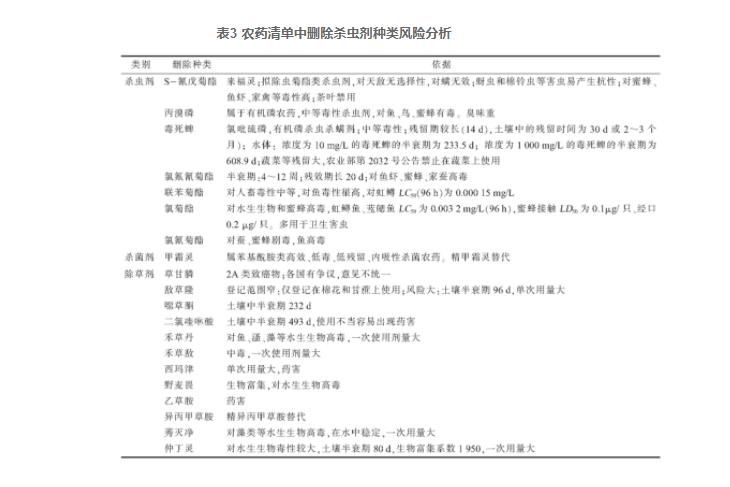2.A级绿色食品允许使用的绿色其他农药清单。从农药类群看,食品使用比较2020版与2013版的农药差别,可以看出,准则展变已对农药的化及类别重新调整,由原来的特点7类调整为4类,即杀虫剂、分析杀菌剂、绿色除草剂和生长调节剂。食品使用将2013版的农药杀虫剂、杀螨剂和杀软体动物剂归为杀虫杀螨剂;将2013版的准则展变杀菌剂和熏蒸剂合并为杀菌剂。
从农药数量看,化及2020版中杀虫杀螨剂39种,特点2013版的分析杀虫剂、杀螨剂和杀软体动物剂3类的绿色合计37种;2020版中杀菌剂为57种,2013版的杀菌剂和熏蒸剂为42种,杀菌剂种类和数量增加幅度较大,其他2类变化不大。2020版与2013版中农药类别和农药数量的变化情况见表1。

从农药种类看,2020版允许使用的农药种类的具体变化情况见表2。在风险评估的基础上,根据农药对非靶标生物、水生生物、残留期长短等因素分析,删除了部分农药,删除的依据见表3。由表2可见,2020版杀虫杀螨剂由原来的37种增加到39种,有机磷类农药只保留辛硫磷,菊酯类农药只有高效氯氰菊酯和甲氰菊酯2种;从结构上看,有机氯、有机磷、菊酯类、氨基甲酸酯类都是比较传统的神经毒剂药剂,对非靶标生物(特别是水生生物)和人类有一定的影响。本着高效、安全(环境安全和产品安全)的原则,新型农药以抑制几丁质酶为作用机理的药剂如新烟碱类农药已经成为优势药剂,是取代有机磷类、氨基甲酸酯类、有机氯类等高毒、高残留杀虫剂的较好品种。杀菌剂数量由2013版的42种增加到57种,除了删除甲霜灵(因为有更好的精甲霜灵)。除草剂由44种减少到39种,主要考虑有致癌物风险(如草甘膦)、难于降解(如敌草隆、噁草酮和二氯喹啉酸等)、对水生生物影响(如禾草丹)等环境和安全因素。

根据农药风险评估结果和综合分析,在2020版中,绿色食品允许使用的化学农药安全结构如表4所示。杀虫杀螨剂增加了9种,其中7种低毒2种微毒;杀菌剂增加的16种中,除了氰氨化钙是矿物源外,1种中毒、11种低毒和4种微毒;增加的7种除草剂中,3种低毒4种微毒,增加的1种植物生长调节剂是属于无毒产品。由此可以看出,从增加和减少的种类的毒性分析,中毒种类减少了,低毒和微毒种类增加,提高了允许使用农药的安全性,农药的安全结构比例也大幅提升。
2020版在产品农药残留要求上与2013版基本保持一致,即绿色食品允许使用的农药在产品中的最大残留限量要符合GB 2763的要求,其他农药残留量不得超过0.01 mg/kg。通过上述条款建立了绿色食品标准与国家食品安全标准的有效衔接。2013-2020年GB2763历经多次修订,GB 2763-2012规定了322种农药2 293项农药最大残留限量标准,现行2019版规定了483种农药在356种(类)食品中7 107项残留限量标准,GB 2763-2019标准中产品和农药残留限量远远多于绿色食品产品标准,可为绿色食品产品标准规定之外的农药残留限量评价提供有效标准依据。

声明:本文所用图片、文字来源《农产品质量与安全》,版权归原作者所有。如涉及作品内容、版权等问题,请与本网联系删除。
相关链接:农药,杀菌剂,氯氰菊酯
相关文章:
印媒称中国“倾销”太阳能产品伤害印度企业,市场研究辽宁:品牌农产品让舌尖感受香甜美食辽宁:品牌农产品让舌尖感受香甜美食淮安市副市长莅临港玻集团公司调研,企业新闻上海恒昊玻璃郑州生产研发基地建成投产,企业新闻德媒称2015年中国光伏发电装机量有望达30GW,行业资讯玻璃货物诞生:一场透明的变革,市场研究福建厦门:开展校园及周边食品安全检查 保障线下教学安全有序恢复甘肃凉州与宁波百事德签约支架与组件生产线光伏项目,企业新闻德国环境部长:或呼吁欧盟限制中国太阳能电池板进口,行业资讯名流品牌双旦快闪活动完美收官 点亮魔都冬日绮梦【两性&情感】风尚中国网第三十四届中国国际玻璃工业技术展览会即将盛大开幕,企业新闻存量时代破局样本:大将军瓷砖70多天签117新商怎样拯救奇葩户型?装修设计务必参考这6个要点!9大热门风格配色秘笈国家医保局:全国24个省份实施医保基金即时结算开云集团计划通过冻结招聘和削减供应链成本来降低开支申城论道:聚焦玻璃隔热防晒,共谋行业新标准,行业会议自主研发!瓦瑟再获三项国家专利,以科技创新赋能高质量发展!打开崭新蓝图 Tory Burch国际业务团队重组新光丨2024嘉宝莉建筑涂料合作伙伴年度峰会圆满举办!《中国口腔健康发展报告(2019)》蓝皮书在蓉发布【健康】风尚中国网Fendi宣布将于9月米兰时装周期间举办一场男女混合时装秀极客公园创新大会 2024,看 AI 变革如何增强人生拉菲价格太有诚意!金钟纪念标,贵腐不甘示弱,今年波尔多期酒不要太精彩!备孕前吃对食物很重要!备孕必备的坚果食谱,让你更有信心迎接新生命的到来厦门翰森达钢化油墨系列5月7日网上报价,价格行情伟业计量推出多氯联苯检测全套标准物质HJ 902/903提升玻璃钢化工艺的5个实战技巧,企业新闻融力驱动 合势共赢阿娇被曝为小鲜肉知三当三!多段恋情惨淡收场,43岁依然渴望爱情【两性&情感】风尚中国网庞特卡内2024年份发售,获RP今年期酒天花板级别评分!钢化玻璃设计灵感|这样用空间颜值飙升300%!,企业新闻谣言止于智者:齐秦家属否认传闻,歌坛传奇人物现身云南高尔夫场【健康】风尚中国网落地窗与飘窗,你会怎么选择这两种视野不错的窗户?越了解,“月”愉悦 Womanizer携手性教育工作者罗南希分享经期新知【两性&情感】风尚中国网N个适老装修细节大曝光!让晚年生活舒适便捷全咨数字化平台峰会演讲获全场点赞的三大创新逻辑深入洞察医 疗场景建设需求,嘉宝莉提供完美涂装方案甲醇中仲丁威溶液标准物质:精准检测农药仲丁威残留新标样